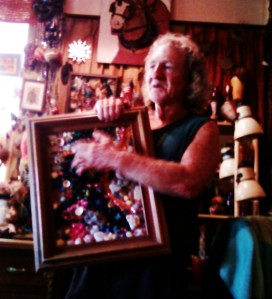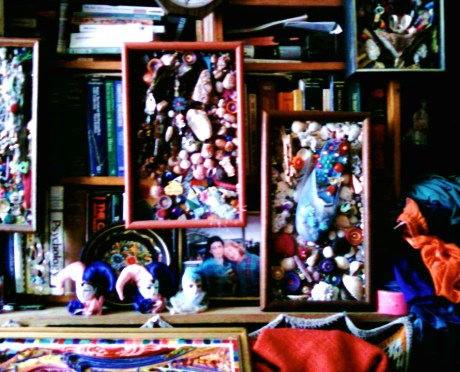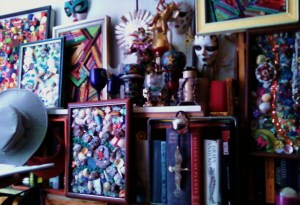Mike “Ringo” White
July 20, 2009
Our class visit to the home of Mike “Ringo” White was a tremendously inspiring, eye-opening experience. The exterior of Ringo’s home was plain and overgrown with greenish plants and foliage, but ascending the stairs and entering through the doorway yielded another world completely. Ringo’s assemblages hung on the walls of his living room, the first space you enter. His works are brightly colored and framed, unbelievably visceral with textures so seductive, they will leave the viewer in awe wondering just what they could possibly be made of. The ins and outs of the wall pieces are accentuated when light hits the surface of the work, glistening and glittering through very large and very small chunks of colored plastics, glass, and stones. The works hang accompanied by some aesthetically similar collected objects such as colorful old glass bottles, porcelain masks, and metal butterflies. This type of décor adorns the entire home, with slight variations from room to room. On the back of Ringo’s pieces, the viewer will find a bus ticket, signifying the date the work was completed; another delicate and wonderful use of the throwaway object. Though the beautiful works of Ringo are ample throughout the dwelling place, it does not feel chaotic or unorganized, but right on the edge, in a poetic way.
The viewer gets the feeling that this man is always working, his finished pieces may not all be in one place, in piles upon piles such as in the home of Bob Watt, another active Milwaukee outsider artist, but the creative impulse is alive and kicking. Ringo guided us through his home and explained to us his creative process and history of art making. He took us to one area in the home where he kept five or six boxes of bottle caps, tons of bags of glass, corks, broken toys and other found treasures. He definitely had a good system for how he collected, from the point of finding, to the point of making and transforming these random objects into something wonderful.
Ringo is originally from Wisconsin, but enjoys frequent travel to Florida to collect more treasures. He started making art in 1983, a day when he ventured to the home of fellow outsider artist Bob Watt, he felt he wanted to do something similar but with different materials. He at one time had an interest in traditional art, he had himself made many landscape paintings and drawings, but this type of art making did not hold the interest of Ringo. As he continued to speak of his work to our class, it became more and more apparent that what Ringo was really doing was acting as an historian of sorts, collecting human-made fossils. He spoke of where he liked to go at certain times of the year to collect specific types of objects or pieces, such as broken plastic children’s sleds in winter that he later sawed up and used to construct a collage image of flowers. He also finds a lot of his treasures at rummage sales and thrift stores, as well as at the beach. He discussed the types of glues and mediums he used to seal the works and the process cleaning and buffing the works once in a while. The depth at which he could speak of where and when the best collecting can be done was beyond belief, “Amazing what you find,” he says.
Ringo mentioned that he generally sold his works to friends for about thirty to forty dollars depending on the size and items included in the piece, he also gave works away as Christmas presents to family members that liked what he made. When asked about art shows he responded that he always gets very good feedback but he cares more about sharing his work than he does about making money.
Artists like Ringo and Bob Watt blur the line between art and life. These two concepts are definitely separated for artists that are more into the business or academic side of the art world. Art and life are separate in the academic art world because when you are learning the forms, techniques, and canons of everything fine art culture, there is no room for personal exploration really, which is where the life part comes in to play. If you want to be affected in a creative way, by nature, you have to be concerned with more than painting that nude or vase of flowers perfect,
“It is inconceivable, the argument goes, that an artist working outside a dominant culture, whether separated internally by incarceration or rejection, or externally through cultural difference and physical distance, will be tainted by its mores” (Rhodes 16).
I honestly feel more soul, more poetry inside of a Ringo piece than I would from an Ingres, though I love Ingres dearly for his infallible technique. It’s kind of like the difference between a record and a CD. Outsider art is the record, superior sound, the purest music experience you will get outside of seeing a live performance, traditional academic art as the CD, mass produced, always a designated level of excellence, but the sound quality of which will never be as pure and true as a record, from the soul.
Ringo isn’t the only Wisconsin Outsider Artist dealing with recycling; Manitowoc’s Rudy Rotter collects many trash objects and excess items from stores and businesses around Manitowoc. He assembles them in a more representational fashion, and has made thousands of works overflowing his three story warehouse studio. Baraboo artist Tom Every, better known as Dr. Evermore, has made a life of collecting huge cast-off industrial materials and assembles them into wonderful narrative sculptures of animals, space ships, and robots. Milwaukee’s Bob Watt appropriates imagery through original and borrowed photos and other images that he will use and reuse hundreds of times in paintings and collages. When Ringo collects objects on the beach, he is essentially exhibiting the pollution conditions of Lake Michigan and the beach area through many seasons and time periods. Bob Watt recycles imagery from various magazines reflecting the media conditions of a given time period. Rudy Rotter recycles local waste objects. Dr. Evermore recycles large industrial parts reflecting yet another telling aspect of our culture. If these artists can make such unbelievably beautiful art objects out of trash, then what’s happening to the other tons and tons of similar waste created by people in this country? I think that’s the real undertone of the awe we feel when viewing these works.
A recent online news story reported about a “10-mile long swath of garbage has just washed onto the Lake Michigan” and “The mass of debris, which apparently came ashore overnight Sunday, sparked a U.S. Coast Guard investigation. A helicopter made reconnaissance flights in hopes of determining where it came from” (Jourdan). The article later revealed that a large sum of this pollution was traced back to somewhere in Wisconsin. This story is just one example of how items can wind up on a beach ready to be collected by and artist like Ringo. Not to mention all of the mercury and ammonias dumped by many fuel companies and other mindless waste. This type of scavengery can be very effective at communicating a place in time, for example what specific objects found say about the contents of the lake this week in the year 2009. Ringo could find a specific toy or type of glasses that could have only been made in this day and age and use them for a work of art. Not to mention the changing biological state of the lake, new fish and invasive species leaving shells and fossils behind can be very much different from lake life twenty years ago. For example, zebra mussels which virtually wiped out all other native clams, and the most recent invasive, spiny water fleas, an organism that can be sexual or asexual, allowing for unbelievably fast reproduction and population (United States Environmental Protection Agency).
It seems that outsider artists like Ringo never turn the radar off when it comes to searching and experiencing art with life, ultimately giving them a more rich and enjoyable experience in my opinion. They never usually have the stress of art show deadlines or other people telling them what to do; they just live their life feeding the creative hunger and impulse inside of them. I can only hope my life becomes similar to this after art school. No one will really be there telling me what or how to make art, so the question becomes “do you make art”, and if you say yes, then what do you make and why do you make it. The right answer will be “for yourself”, but that is something I haven’t experienced for years. So I guess the point of this is that if I can achieve the type of happiness and clarity the outsiders demonstrate, everything will be worth it. What happens when art and life become entwined? Peace, purity, and personal progress, the lifestyle that is basically the whole point of being an artist, at least to me.
Works Cited
All photos by me.
As discussed in class meeting with Mike “Ringo” White.
Rhodes, Colin. Outsider Art: Spontaneous Alternatives. London: Thames & Hudson Ltd, 2004.
Jourdan, Kristi. Garbage Along Lake Michigan Shore Came from Single Source, Hits Private Beaches in Holland. Grand Rapids Press. 2009. <http://blog.mlive.com/grpress/2008/07/garbage_along_lake_michigan_sh.html>
United States Environmental Protection Agency. Invasive Species. Great Lakes Pollution Prevention and Toxics Reduction. 2009. <http://www.epa.gov/glnpo/invasive/>
QUESTION FOR THE CLASS
How do you think art and life function or don’t function in regards to artists like Ringo and Bob Watt verses more mainstream “traditional” artists?




I like what you said about Ringo’s pieces rendering the viewer “in awe wondering just what they could possibly be made of”. I felt the same way, especially the pieces that were made of broken pieces of sleds; I’ve never seen them or broken them myself, as a kid. He made it seem so common but it really just attested to his careful method of looking and gathering. It was amazing how much you could read in his works of the time and location they were made in.
It’s very strange to meet someone who actually lives through their art. It’s a state that all artists try to achieve but never seem to fully attain. Students of art spend copious amounts of money on training, and expect that training to yield a profit in the end. These artist generally expect nothing from their art. The act of creating and the pleasure it brings those around them is the profit.
Your account of Ringo’s house was beautiful. It both described and analyzed and then broadened the discussion to larger issues about culture and being an artist. Your statement that Ringo is a historian, collecting human-made fossils was especially insightful and nicely stated. I’m so happy to see this kind of writing and thinking coming out of our experiences.